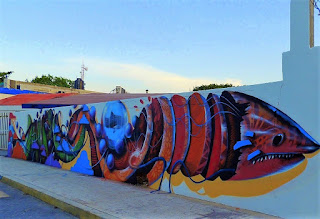 |
| Dance troupe, whale shark statue on Isla Mujeres |
 |
| Sunrise side of Isla Mujeres |
Recently, we have seen an increase in bright,
cheerful signs simply proclaiming – Isla Mujeres.
We think the signs have been installed to
help combat TCS, tourist-confusion-syndrome. Symptoms of TCS include an
inability to distinguish between one city and another. Sufferers of TCS are
usually oblivious to their surroundings due to the overuse of selfie-sticks and
alcohol.
Conversations with a visitor who suffers from TCS can sound something like
this:
“This is my favourite part of Cancun,” the bikini-clad
woman said.
“Cancun?” The islander asked, his eyebrows lifting,
questioning. Then he noticed the woman was wearing an identification wristband
from an all-inclusive resort located on the Riviera Maya.
“Yes, we are on a day trip from the hotel
zone. This is my favourite part of
Cancun.”
“Actually, this isn't Cancun.” He patiently
replied, “We're a separate community. This is Isla Mujeres.”
“Oh! I’ve never heard of it,” she said.
 |
| Arriving on Isla Mujeres |
If you are here on a day-trip, the first indication that you
aren’t in Cancun is the enormous metal sign spread across the top of the
Ultramar passenger ferry terminal – Isla Mujeres. Snap a phone pic of that one
to help you remember where you were.
Or just a few steps from the boat, at the
head of the wharf, is another photo opportunity – an anchor, a painted wooden
sign, and the beautiful blue ocean. During the Christmas holidays, an enormous
inflatable, woolly bear complete with Santa hat and scarf sits beside the anchor.
It is an ideal stop for a memory-jogging photo.
 |
| Whale Shark statue at night |
There
is a large whale shark statue, suspended over a sculpture of a small fishing
boat, a panga. It is located about
five minutes south of Centro, on the western side where the Malécon runs along the water’s edge. The statue is a popular place to stop for a
touristy photo. Driving past this area can be interesting when golf-cart
drivers suddenly brake and swerve to the curb, pointing excitedly at the statue
with their selfie-stick.
 |
| Isla on the winter solstice, December 21st |
For the folks who are only visiting for a few hours and plan to
walk around Centro, one of the newer
tourist stores on the double-wide Rueda Medina Avenue, Plaza Don Agustin, has a
perfect place for a memory-jogging photo inside their store.
On the wall is a depiction of a whale shark
along with the name of our community.
In the same neighbourhood is the Miramar Restaurante, located on Rueda
Medina Avenue and across from the Señor Frog store. After enjoying a snack, or
lunch, or perhaps a cold beverage, you can walk out on their dock for yet another
Isla Mujeres photo op.
Islanders try their best to help cure TCS,
tourist-confusion-syndrome.
Now, if someone could convince the souvenir salespeople to
stop selling Cancun-branded t-shirts and touristy gee-gaws, maybe we could
make some real progress.
Cheers, Lynda, Lawrie, and Sparky
or
































